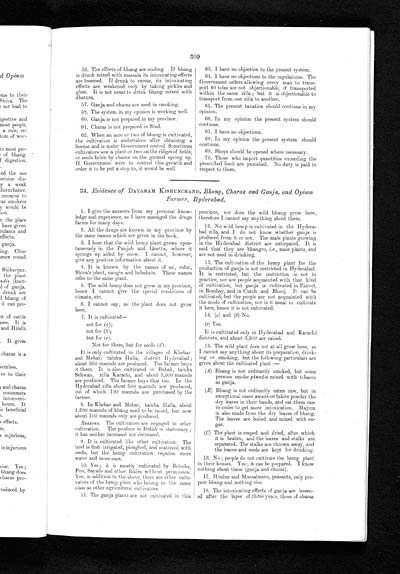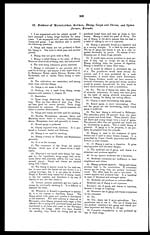Medicine - Drugs > Report of the Indian Hemp Drugs Commission, 1894-1895 > Volume VII > Evidence of Sind witnesses
(327) Page 309
Download files
Individual page:
Thumbnail gallery: Grid view | List view

309
56. The effects of bhang are cooling. If bhang
is drunk mixed with massala its intoxicating effects
are lessened. If drunk to excess, its intoxicating
effects are weakened only by taking pickles and
ghee. It is not usual to drink bhang mixed with
dhatura.
57. Ganja and charas are used in smoking.
58. The system in my opinion is working well.
60. Ganja is not prepared in my province.
61. Charas is not prepared in Sind.
62. When an acre or two of bhang is cultivated,
the cultivation is undertaken after obtaining a
license and is under Government control. Sometimes
cultivators sow a plant or two on the ridges of fields,
or seeds fallen by chance on the ground spring up.
If Government were to control this growth and
order it to be put a stop to, it would be well.
63. I have no objection to the present system.
64. I have no objections to the regulations. The
Government orders allowing every man to trans-
port 40 tolas are not objectionable, if transported
within the same zilla; but it is objectionable to
transport from one zilla, to another.
65. The present taxation should continue in my
opinion.
66. In my opinion the present system should
continue.
67. I have no objections.
68. In my opinion the present system should
continue.
69. Shops should be opened where necessary.
70. Those who import quantities exceeding the
prescribed limit are punished. No duty is paid in
respect to them.
34. Evidence of DAYARAM KISHUNCHAND, Bhang, Charas and Ganja, and Opium
Farmer, Hyderabad.
1. I give the answers from my personal know-
ledge and experience, as I have managed the drugs
farms for many days.
2. All the drugs are known in my province by
the same names which are given in the book.
3. I hear that the wild hemp plant grows spon-
taneously in the Punjab and Quetta, where it
springs up aided by snow. I cannot, however,
give any positive information about it.
4. It is known by the names of sai, subzi,
Shiva's plant, nangin and bubakain. These names
refer to the same plant.
5. The wild hemp does not grow in my province,
hence I cannot give the special conditions of
climate, etc.
6. I cannot say, as the plant does not grow
here.
7. It is cultivated—
not for (a);
not for (b);
but for (c).
Not for fibres, but for seeds (d).
It is only cultivated in the villages of Khebar
and Mehar, taluka Halla, district Hyderabad;
about 500 maunds are produced. The farmer buys
it there. It is also cultivated in Bubak, taluka
Sehwan, zilla Karachi, and about 3,000 maunds
are produced. The farmer buys that too. In the
Hyderabad zilla about 500 maunds are produced,
out of which 100 maunds are purchased by the
farmer.
8. In Khebar and Mehar, taluka Halla, about
1,200 maunds of bhang used to be raised, but now
about 100 maunds only are produced.
Reasons. The cultivators are engaged in other
cultivation. The produce in Bubak is stationary;
it has neither increased nor decreased.
9. It is cultivated like other cultivation. The
land is first irrigated, ploughed, and scattered with
seeds, but the hemp cultivation requires more
water and more care.
10. Yes; it is mostly cultivated by Belochs,
Pirs, Sayads and other fakirs without permission.
Yes, in addition to the above, there are other culti-
vators of the hemp plant who belong to the same
class as other agricultural cultivators.
11. The ganja plants are not cultivated in this
province, nor does the wild bhang grow here,
therefore I cannot say anything about them.
12. No wild hemp is cultivated in the Hydera-
bad zilla, and I do not know whether ganja is
produced from it or not. The male plants growing
in the Hyderabad district are extirpated. It is
said that they are bhangro,i.e., male plants, and
are not used in drinking.
13. The cultivation of the hemp plant for the
production of ganja is not restricted in Hyderabad.
It is restricted, but the restriction is not in
practice, nor are people acquainted with that kind
of cultivation, but ganja is cultivated in Panvel,
in Bombay, and in Cutch and Bhooj. It can be
cultivated, but the people are not acquainted with
the mode of cultivation, nor is it usual to cultivate
it here, hence it is not cultivated.
14. (a) and (b) No.
(c) Yes.
It is cultivated only in Hyderabad and Karachi
districts, and about 3,500 are raised.
15. The wild plant does not at all grow here, so
I cannot say anything about its preparation, drink-
ing or smoking, but the following particulars are
given about the cultivated plant: —
(A) Bhang is not ordinarily smoked, but some
persons smoke ghundis mixed with tobacco
as ganja.
(B) Bhang is not ordinarily eaten raw, but in
exceptional cases awadhoot fakirs powder the
dry leaves in their hands, and eat them raw
in order to get more intoxication. Majum
is also made from the dry leaves of bhang.
The leaves are boiled and mixed with su-
gar.
(C) The plant is reaped and dried, after which
it is beaten, and the leaves and stalks are
separated. The stalks are thrown away, and
the leaves and seeds are kept for drinking.
16. No; people do not cultivate the hemp plant
in their houses. Yes; it can be prepared. I know
nothing about these (ganja and charas).
17. Hindus and Mussalmans, peasants, only pre-
pare bhang and nothing else.
18. The intoxicating effects of ganja are lessen-
ed after the lapse of three years, those of charas
Set display mode to: Large image | Zoom image | Transcription
Images and transcriptions on this page, including medium image downloads, may be used under the Creative Commons Attribution 4.0 International Licence unless otherwise stated. ![]()
| India Papers > Medicine - Drugs > Report of the Indian Hemp Drugs Commission, 1894-1895 > Volume VII > Evidence of Sind witnesses > (327) Page 309 |
|---|
| Permanent URL | https://digital.nls.uk/74911573 |
|---|




